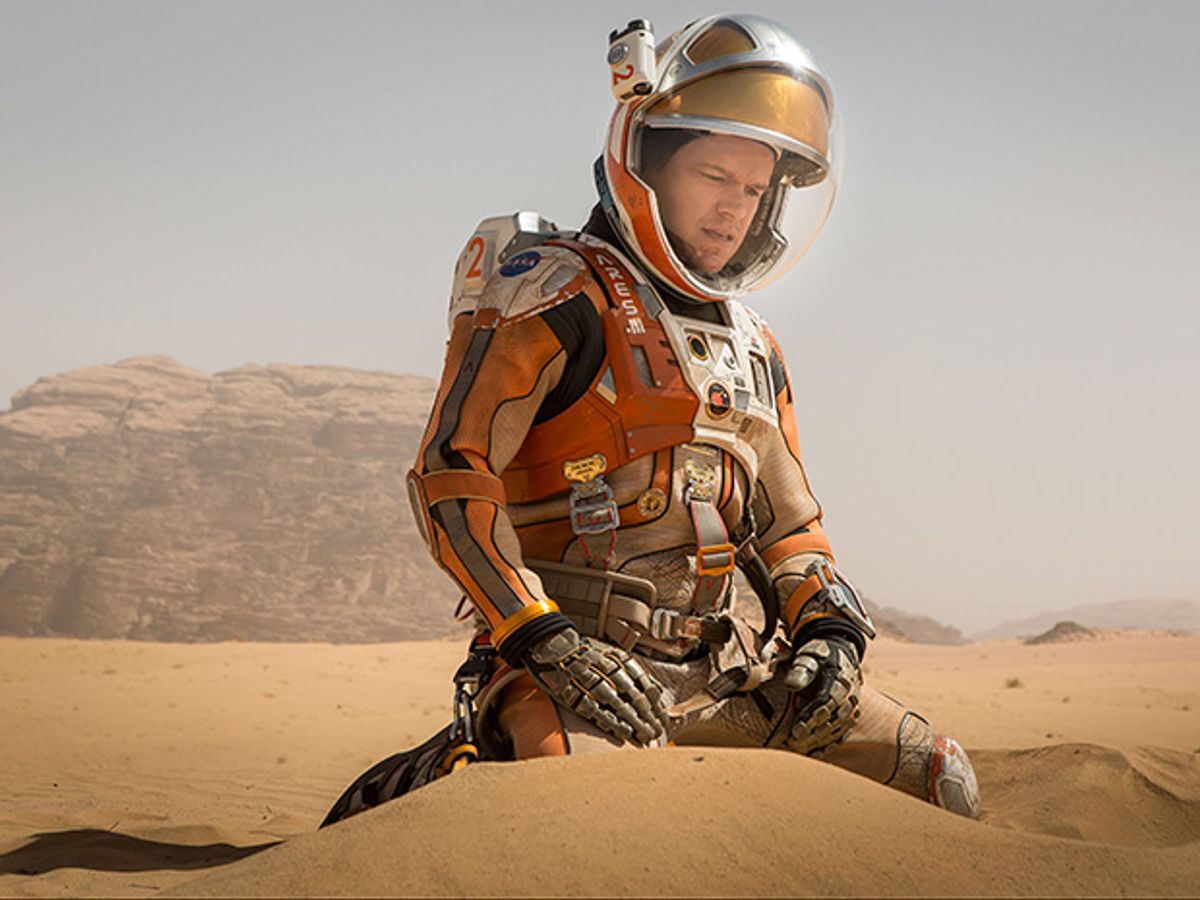Editors Note: James Oberg is a regular contributor to IEEE Spectrum and a former NASA mission controller at Johnson Space Center who specialized in orbital rendezvous maneuvers.
The Martian movie is a dream come true, a faithful elucidation of the central technical dramas that made the Andy Weir novel it’s based on the surprise ‘space geek hit’ of the decade. The tale is something of a Robinson Crusoe in space: Astronaut Mark Watney is stranded on the surface of Mars when his crew mates are forced to evacuate their habitat and blast off for Earth. Watney must improvise ways to eke out his limited resources, as the next mission to the red planet isn’t scheduled to land for another four years. Like the book, the movie’s rhythm is a steady cycle of crisis, recovery, humor, determination, and new crisis. On screen, directed by Ridley Scott, these cycles are delivered with satisfying characterization and eye-grabbing visuals of Martian landscapes and mouth-gaping zero-G gymnastics in space.
As a backdrop to the human drama (and comedy), the movie’s hardware is based on real engineering, not magical miracle machines. The Hermes mother ship, for example, is a modified version of the sound design strategy of a ‘cycling spacecraft’ that repeatedly makes the Earth-Mars-Earth loop with crew and small landing craft. (Buzz Aldrin and I wrote up the concept for Scientific American a decade ago.)
As the left-for-dead Watney, played by Matt Damon, faces doom in a dozen guises, he defiantly boosts his courage through styling himself as everything from the “best botanist on Mars” (as he ingeniously grows potatoes in carefully-created garden soil) to a “space pirate” (for his goal of commandeering a rescue rocket emplaced automatically elsewhere on the planet). He expresses his thoughts to his laptop log and later in messages to people on earth campaigning to rescue him. When humans finally reach other planets, we will need real “Watneys”—those smart enough to repurpose on-hand assets in an emergency, and lucky enough not to be killed by their own inevitable oversights.
Space geeks will enjoy identifying and debating technical flaws in the film. The Martian follows its source material remarkably closely, but unlike say, certain installments in the Harry Potter movie franchise, it will still make perfect sense to those who haven’t read the book. Aside from the monster sandstorm that sets up the crisis (Andy Weir, the author of The Martian, is very upfront about choosing to gloss over the realities of Martian atmospheric pressure in favor of a dramatic opening), there are few noticeable factual flubs in the plot. Unlike 2013’s Gravity and its magical space maneuvers, or 2014’s Interstellar with its mystical time continuum tricks, this movie is a remarkably authentic exposition of what space travelers need to be able to do under crisis conditions.
Run time constraints forced the movie’s producers to condense and combine characters, with no real detriment to the story—although viewers might be surprised to see the same set of key NASA experts showing up at every launch or space center on the planet as the action shifts between continents. Similar story-telling imperatives probably compelled the most striking departure (spoiler alert!) from the book—changing who actually goes to rescue Watney in the end—but again, without any significant detour from the plot.
There’s no cheating on even highly-technical spaceflight topics, as shown in the treatment of the so-called “Rich Purnell maneuver,” wherein the Hermes slingshots past Earth back to Mars for a desperate pickup attempt. NASA’s navigation geek Purnell—played with effective nervous energy by Donald Glover— demonstrates the “orbitology” of his maneuver, with two NASA officials as the planets, and a stapler and pens as spacecraft. The result is coherent, comprehensive, and surprisingly comic. The basic strategy of the Rich Purnell maneuver is not fictional—a crippled Japanese Mars probe named Nozomi actually used a similar Earth-flyby scheme to set up a second chance for its own faltering unmanned Mars mission a dozen years ago.
There’s one cringeworthy trope in The Martian that has apparently become an unavoidable cultural myth: the scenes where teams in Mission Control erupt into leaping cheers a few seconds after a rocket blasts off. This imaginary practice would not only be utterly unprofessional but also an indicator of near-criminal negligence. In the screening that I attended following an event at NASA’s Johnson Space Center, these scenes were negatively noticed by many NASA folks in the audience. But I only can suppose it was sympathetically meant to humanize the rocket scientists, and it was the only exception to the admiration shown for all the other portrayals. (It’s also possible this trope has been influenced by footage of the controllers of deep space unmanned missions in recent years, where data about events can take hours to cross the solar system, leaving controllers mostly in the position of spectators during key mission milestones.)
After faithfully reproducing technically-sound crises and responses for two hours, the movie did briefly run off the track into fantasy mode at the very end, by by violating the physics of action-reaction in portraying an over-dramatized dramatic rescue attempt that really didn't need any such cheating. But if that was the price to pay for producing this otherwise magnificent space adventure story, the math checked out. Mother Nature is relentlessly unforgiving in space, but a movie audience can show a lot more mercy to one major technical transgression. I do.
James Oberg is a retired "rocket scientist" in Texas, after a 20+ year career in NASA Mission Control and subsequently an on-air space consultant for ABC News and then NBC News. The author of a dozen books and hundreds of magazine articles on the past, present, and potential future of space exploration, he has reported from space launch and operations centers across the United States and Russia and North Korea.



